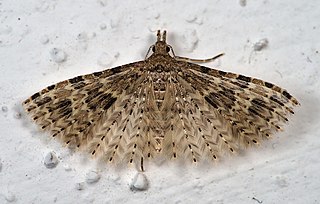Related Research Articles

In mathematics, convolution is a mathematical operation on two functions that produces a third function. The term convolution refers to both the result function and to the process of computing it. It is defined as the integral of the product of the two functions after one is reflected about the y-axis and shifted. The integral is evaluated for all values of shift, producing the convolution function. The choice of which function is reflected and shifted before the integral does not change the integral result. Graphically, it expresses how the 'shape' of one function is modified by the other.

G, or g, is the seventh letter in the Latin alphabet, used in the modern English alphabet, the alphabets of other western European languages and others worldwide. Its name in English is gee, plural gees.

The uncertainty principle, also known as Heisenberg's indeterminacy principle, is a fundamental concept in quantum mechanics. It states that there is a limit to the precision with which certain pairs of physical properties, such as position and momentum, can be simultaneously known. In other words, the more accurately one property is measured, the less accurately the other property can be known.

In physics, engineering and mathematics, the Fourier transform (FT) is an integral transform that converts a function into a form that describes the frequencies present in the original function. The output of the transform is a complex-valued function of frequency. The term Fourier transform refers to both this complex-valued function and the mathematical operation. When a distinction needs to be made the Fourier transform is sometimes called the frequency domain representation of the original function. The Fourier transform is analogous to decomposing the sound of a musical chord into the intensities of its constituent pitches.

In thermodynamics, the Gibbs free energy is a thermodynamic potential that can be used to calculate the maximum amount of work, other than pressure-volume work, that may be performed by a thermodynamically closed system at constant temperature and pressure. It also provides a necessary condition for processes such as chemical reactions that may occur under these conditions. The Gibbs free energy is expressed as

The Alucitidae or many-plumed moths are a family of moths with unusually modified wings. Both fore- and hind-wings consist of about six rigid spines, from which radiate flexible bristles creating a structure similar to a bird's feather.

Kenneth Bruce Gorelick, known professionally as Kenny G, is an American smooth jazz saxophonist, composer, and producer. His 1986 album Duotones brought him commercial success. Kenny G is one of the best-selling artists of all time, with global sales totaling more than 75 million records.

Cymindis is a genus of ground beetle native to the Palearctic, the Near East, and North Africa. It contains the following species:
Pterotopteryx is a genus of moths in the family Alucitidae. The genus was described by Hans-Joachim Hannemann in 1959.

Pterotopteryx dodecadactyla is a moth of the family Alucitidae. It is found in Russia, Croatia, Slovenia, Hungary, Romania, Austria, Slovakia, the Czech Republic, Poland, Estonia, Fennoscandia, Germany, Switzerland, France and Italy. It has also been recorded from Gabon.
Pterotopteryx lonicericola is a moth of the family Alucitidae. It is found in Russia, as well as Tajikistan.
Pterotopteryx colchica is a moth of the family Alucitidae. It was described by Zagulajev in 1992. It is found in Adjara.
Pterotopteryx koreana is a moth of the family Alucitidae. It was described by Bong-Kyu Byun in 2006 and is endemic to Gangwon Province, South Korea, Korea.
Pterotopteryx monticola is a moth of the family Alucitidae. It was described by Zagulajev in 1992. It is found in Russia.
Pterotopteryx spilodesma is a moth of the family Alucitidae. It was described by Edward Meyrick in 1907. It is found in Russia and from southern India and Pakistan to Japan. It has also been recorded from Korea.
Pterotopteryx synaphodactyla is a moth of the family Alucitidae. It was described by Sergei Alphéraky in 1876. It is found in Russia.
Pterotopteryx vietana is a moth of the family Alucitidae. It was described by Bong-Kyu Byun and Kyu-Tek Park in 2007. It is found in Vietnam.
P. koreana may refer to:
Proutia is a genus of moths belonging to the family Psychidae.
References
- ↑ Beccaloni, G.; Scoble, M.; Kitching, I.; Simonsen, T.; Robinson, G.; Pitkin, B.; Hine, A.; Lyal, C., eds. (2003). "Pterotopteryx tshatkalica". The Global Lepidoptera Names Index . Natural History Museum . Retrieved May 13, 2018.